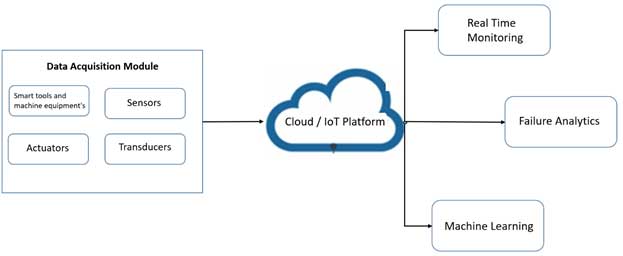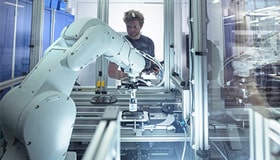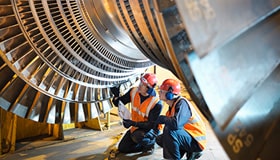IoT based industrial performance maintenance and safety
The continued demand for sustainability and better efficiency spurs innovation in industrial automation. The Internet of Things (IoT) enabled advanced technologies to be swiftly integrated into industrial automation. Smart and fully connected factories allow manufacturers to enhance process efficiency, safety, and sustainability whilst reducing costs.
Safety and maintenance are important to keep facilities and equipment in their functional state. Maintenance guarantees industrial productivity and regular maintenance leads to healthier and safer working conditions. Inadequate maintenance, or lack of the same, may cause serious health problems and deadly accidents. This article delves into the ways that IoT sensors and software working in tandem offers solutions to boost both production maintenance and safety.
Maintenance
Maintenance functions continue to evolve from being a response to a system failure, to planning, and then to predictive, and culminating (until now) in self-fixing. The progress of operational sensor technologies combined with success in information technologies helps to extract real-time performance data. These technologies including cloud-based analytics and platforms, Augmented Reality (AR), and Virtual Reality (VR), outline scheduled or predictive maintenance with negligible productivity loss.
Industrial maintenance is classified into different types:
Corrective Maintenance
Corrective maintenance is performed to identify, isolate, and rectify faults. The failed equipment, machine, or asset is then restored to an operational condition within the tolerances or limits established for normal operations.
Preventive Maintenance
Preventive maintenance refers to regular, routine maintenance to help keep equipment up and running, prevent any unplanned downtime, and curb expensive costs from unanticipated equipment failure.
Predictive Maintenance
Predictive maintenance techniques monitor the condition and performance of equipment during normal operation to predict when maintenance should be performed. It reports on the machine’s status and operational capacity by monitoring the values of specific variables and consequently generates data-driven decisions.
Shutdown Maintenance
Through shutdown maintenance, the parts which are known to experience age and use-related degradation are automatically replaced on a set frequency shorter than the mean time between failures. Such actions prevent unexpected failure and facilitate maximum production.
Periodic Maintenance
Periodic maintenance is maintenance performed on equipment based on a calendar schedule. It consists of a series of primary tasks like data collection, visual inspections, cleaning, and lubrication.
Safety
The safety factor is paramount during all production stages, such as design, manufacturing, installation, adjustment, operation, maintenance, and final scrapping. The Machinery Directive compels manufacturers to guarantee a minimum safety level for machinery and testing equipment such as multi-meters and thermal imagers. Machines and tools must conform to the Essential Health and Safety Requirements (EHSRs) listed in the Directive and are therefore required to provide a standard minimum level of protection.
How the IoT Can Contribute to Plant Safety & Maintenance
Implementing IoT solutions radically increases operational efficiency. IoT improves machine efficiency by tracking performance and predicts failures ahead of time. Unplanned downtime is thus eliminated. Industrial IoT also creates a safer workplace. Industries investing in smart production and manufacturing systems expect sustainable and optimal production with minimal maintenance. This makes maintenance a vital industrial aspect. Systems such as Condition Based Monitoring (CBM) or Computerized Maintenance Management System (CMMS), Enterprise Resource Planning (ERP), and Manufacturing Execution System (MES) execute maintenance activities in multiple industries. These systems offer features like preventive and predictive maintenance, maintenance planning, maintenance scheduling, execution, traceability, and monitoring. Newark offers a wide range of maintenance, repair, and safety products from numerous leading brands. Keep production plant, machinery, and safety equipment well maintained with our range of components, tools, and equipment. (For more information on products please Click here & here)
Condition-Based Monitoring, Predictive Maintenance and the IoT
The condition of a machine in condition-based monitoring (CBM) is continuously monitored by observing pre-defined equipment parameters. This reveals patterns that may indicate equipment failure. CBM Systems monitor parameters like equipment vibration, temperature variations, oil levels, motor voltage, and current. Such measured data may be analysed so as to generate a suitable course of action.
IoT technology allows manufacturers and users to effortlessly solve technology issues at a reduced cost. Instrumentation sensors are now cheaper, more rugged, reliable, and offer wider functionality. Robust wireless protocols allow actionable data to be collated from the sensors into a local gateway for immediate analysis and filtering. As shown in the following figure, it can then be transferred over the Internet to a cloud-based computing resource that offers software as a service to users of all sizes. Such software can store the data and perform all analysis necessary to spot trends and identify potential trouble spots.
Once these parameters are available for analysis, a failure model can be built to spot deviations from these baselines. This is simple to set up if the combinations of parameter values that indicate failure are known. A set of rules for failure conditions can be defined, and classical data analytics and mathematics used to build the right model. However, if the causes of failure are not well understood, data science and machine learning will be necessary to develop algorithms that can spot significant patterns in the data.

Figure 1: Predictive Maintenance using IoT Platform
Improving Plant Safety & Security Using IoT
Improved maintenance equals better plant productivity. This productivity can be further increased if plant managers fulfill their legal and moral obligations to optimize on-site safety. Plant safety and security can be enabled by IoT technology combined with big data analysis. KPIs such as employee absences, vehicle mishaps, property damage, near misses, injuries, or any loss or damage that happens during normal daily operations can be monitored.
Often, if left to human reporting alone, many of these metrics can ‘slip through the cracks’ as they are either unreported or under-reported. IoT enables better safety overall by ensuring real-time insights into these key areas. Any issues that arise can be solved immediately, assuring compliance with health and safety regulations and environmental concerns.
Workplace injury is a good example as minor injuries are often unreported. Sometimes, they go on to become bigger issues over time, but the conundrum is how to be able to connect a larger problem back to a previous incident.
IoT wearables can provide a solution to this problem as employees will be monitored constantly for various health metrics, including heart rate, movement, activity, fatigue, stress and so on. They will also provide a means to deliver important safety information, thereby reducing insurance costs for liability and improving compliance throughout the workforce.
Digital tagging can also help track the workforce. Specifically geared towards high-risk industries such as mining, tagging technology lets management know exactly who is on the job site, how long they have been there for and ensure that nobody is forgotten or left behind in case of an emergency.
Specialist Predictive Maintenance Sensors
Specialist sensors also offer an in-depth insight into the factory condition and (any) unfolding problems. IoT technologies related to worker safety do not just simply supervise workers but also their immediate ecosystem. Outdoor workplaces like construction sites and mines involve diverse environmental factors that may endanger workers. Thermal image cameras and IoT sensors may detect incoming hostile weather conditions and extreme temperatures. This information may be used to warn workers of these perils. Motion trackers are an excellent example of specialist predictive maintenance sensors. These alert employees when they come near a hazardous area such as an unstable or a slippery floor.
AI’s Growing Contribution to Predictive Maintenance
Another term related to condition-based maintenance is predictive quality and maintenance or PQM. PQM solutions harness data gathered from both IoT and traditional legacy systems. They focus on detection and solve quality or maintenance issues before they become serious problems, causing downtime.
PQM solutions employ algorithms and produce average statistics to predict when quality corrections or maintenance is required. AI-based PQM solutions use several technologies together including machine learning, deep learning, and cognitive computing.
Conclusion
A holistic perspective of asset management is necessary to learn the true worth of IoT. The IoT technologies with their numerous field centers linked to systems that collate their data and execute sophisticated analysis, offer new insights into plant conditions in real-time. High-powered virtual cloud networks continually collect, aggregate, and model data to anticipate failures. Contingencies will be put in place to restrict their impact on system availability. The IoT key to improving driving cost and asset reliability is to deliver real-time, actionable and intelligent data to the end-user or connected systems. Factories welcome newer and better efficient maintenance possibilities to remain competitive through ever-improving uptimes.






